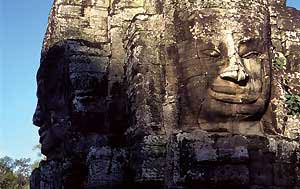Cambodia
Background
Travellers with a taste for leaving the beaten track are rediscovering Cambodia and loving what they find. Cambodia is friendly, uncrowded, gorgeous, and a largely unexplored alternative to more developed Thailand and Vietnam.
The ancient temples of Angkor Wat are undoubtedly the biggest draw in Cambodia. Once the capital of a vast Khmer empire, these hundred or so temples were built between the 9th and 13th centuries. Some sit slowly crumbling beneath sprawling jungle trees; others are covered in intricate carvings of heavenly dancers. The iconic silhouette of Angkor Wat -- it adorns every Cambodian flag -- and the giant, benign smiling faces of Bayon are unlike anything else in the world.
Cambodia's capital Phnom Penh may not offer the range of ancient and colonial architecture boasted by Hanoi or Bangkok, but Phnom Penh has to be one of the liveliest cities in the region. Driving around Phnom Penh on the back of a moto can be an entirely un-metaphorical pain in the behind, but the city's hyperactive bar scene promises to cure even the most lingering aches: from colonial cocktails in a wicker and linen atmosphere to Angkor draft and a driving beat, Phnom Penh's nightlife has all tastes covered, as do its plethora of restaurants.
Highlights
Angkor Wat
 The highlight of every trip to Cambodia is a visit to the Angkor Wat temple complex. Scattered across an area the size of modern-day Los Angeles, the complex comprises more than 1,000 major and minor temples, many still half strangled by the surrounding jungle, many still yet undiscovered.
The highlight of every trip to Cambodia is a visit to the Angkor Wat temple complex. Scattered across an area the size of modern-day Los Angeles, the complex comprises more than 1,000 major and minor temples, many still half strangled by the surrounding jungle, many still yet undiscovered.
Named after the most magnificent temple of all, Angkor Wat, the city was built during the height of Angkorean civilisation from the 9th to 12th centuries. As the Angkorean reign came to close in the 1400s, the city was abandoned to the encroaching jungle.
And there it stayed, unknown to the outside world, until 1860, when French botanist Henri Mahout "rediscovered" the lost city.
News of Angkor in Europe reignited the continent's fascination with "exotic Asia". Angkor Wat epitomised the romantic view of a "lost" city, overgrown with jungle creepers, through which emerged the enigmatic faces of the Bayon.
Recent history, however, has been less than kind to the temples. The Khmer Rouge sold Angkorean artifacts to help fund their genocidal regime in the 1970s and later their jungle resistance in the 1980s. They used the elegantly carved apsara for target practice. In the years immediately after the war looters picked up where the Khmer Rouge left off, funneling hundreds if not thousands of priceless cultural artifacts into the global antiquities black market.
More recently, restoration projects led by UNESCO and others have tried to undo the damage done. The projects have mostly met with success, and the new work only embellishes the grandeur of one of the world's most prestigious archaeological sites.
Phnom Penh
 Once a tranquil city of wide boulevards and French colonial villas, the capital Phnom Penh has suffered the same destructive fate as the rest of the country. Signs of poverty remain ever present, and scars of the past are never far from view.
Once a tranquil city of wide boulevards and French colonial villas, the capital Phnom Penh has suffered the same destructive fate as the rest of the country. Signs of poverty remain ever present, and scars of the past are never far from view.
Yet Phnom Penh is making a superhuman effort to put its troubled history behind it. Construction has been booming for years, and the city is undergoing a resurgence of sorts. Bars and cafes dot the riverside. A growing number of high-end hotels are sprouting up to cater to the burgeoning influx of foreign travelers. Art exhibits by local artists are common. Galleries are plentiful, and the art is good quality and inexpensive. Restaurants catering to foreign tastes number in the hundreds, and Phnom Penh offers dining options as diverse as capital cities ten times her size.
After dark options include a thriving bar scene.
Transport
 Traveling overland to Cambodia's major destinations, in most cases, is typically a pleasant-enough experience. While far from perfect, the nation's road network is vastly improved over years past and luxury buses and private taxis operate between most major cities.
Traveling overland to Cambodia's major destinations, in most cases, is typically a pleasant-enough experience. While far from perfect, the nation's road network is vastly improved over years past and luxury buses and private taxis operate between most major cities.
River travel is also possible for much of the year, and trips along the Mekong and Tonle Sap provide an excellent alternative for the adventurous traveler.
For speed and reliability, flying is still the best bet. Service between Phnom Penh and Siem Reap, the gateway to Angkor Wat, departs daily. Flights to regional capitals typically depart once or twice per week.
Cambodia in Pictures
 Cambodia in Pictures
Cambodia in Pictures



